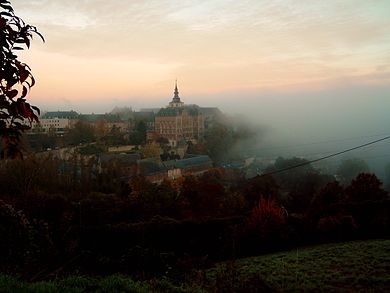Floreffe Abbey
The Floreffe Abbey (Latin Abbatia Floreffensis ) was the second establishment of a settlement by the Premonstratensian Order . The abbey is located in the village of Floreffe on the Sambre River , about eleven kilometers southwest of the Belgian city of Namur .
history
In the year after the foundation of the Premonstratensian Order, the founder of the order Norbert von Xanten returned to their castle in Namur with the relics intended for the new church in Prémontré with Gottfried , the Count of Namur , and his wife Ermesinde on his way from Cologne to Prémontré . His character impressed his two hosts so much that they asked him to found a house of his order in the nearby village of Floreffe.
The donation agreement for a church and buildings usable for the abbey to the Premonstratensians was signed on November 27, 1121, so the branch in Floreffe is chronologically the second abbey of the order. Norbert laid the foundation stone for the church, which was to be named Salve , and the name Flos Mariae ("Flower of Mary") was chosen for the abbey .
According to the abbey records, Norbert saw a drop of blood fall from the sacred host onto the plate during mass. In response to his question, the deacon who was also present confirmed his observation. The altar at which Norbert read mass back then is still in Floreffe.
Richard, one of the first to join Norbert, was appointed first abbot by him. The second abbot Almaric was sent to Palestine by Pope Innocent II to preach the Gospel . Several brothers from Floreffe accompanied him to the Holy Land, where in 1137 he founded the Abbey of St. Habacuc. Philip, Count of Namur, gave the sixth abbot Weric a large piece of the cross of Christ that he had received from his brother Baldwin I , the ruler of Constantinople. The records mention two years, namely 1204 and 1254, in which blood dripped from the relic on the feast day of the Exaltation of the Cross , in the presence of the clergy and a large crowd. At the time of the abolition of the monastery, the relic was brought to safety and returned to them years later, when the canons expelled from France had acquired an old Augustinian canon monastery in Bois-Seigneur-Isaac .
Various abbeys were founded from Floreffe Abbey, including in 1138 in Mol - Postel, initially as a priory, the later Postel Abbey , in 1152 the Abbey in Leffe and as early as 1122 the Abbey in Wenau . In 1135, at the request of the Bishop of Trier, the Premonstratensians settled in the Rommersdorf Abbey, which had been abandoned by the Benedictines .
Count Heinrich IV was buried in Floreffe.
Abolition of the monastery
The abbot Louis de Fromantau, elected in 1791, was the 55th and last abbot in Floreffe. With the occupation of the Austrian Netherlands by the army of the First French Republic , all clergymen were expelled and the abbey and all its possessions were confiscated. It was up for sale in 1797 and was acquired for the abbot and his convent by Canon Richald, posing as a Republican. After the Concordat of 1801 , the abbot returned to the abbey with some brothers. The difficulties were insurmountable, however, after the death of the last member of the convent, the abbey fell to the Bishop of Namur , who set up a seminary in Floreffe.
seminar
The seminar still exists in the abbey today. Many of the earlier buildings are still there and can be viewed during the seminar's opening hours.
beer
The monastery’s own Floreffe beer has been brewed and sold under license by the Brasserie Lefebvre in Quenast, a sub-municipality of Rebecq , since 1983 ; there are Floreffe in the varieties Blond , Dubbel , Tripel and Prima Melior .
literature
- AAVV: Floreffe; 850 ans d'histoire , Liège, 1973 (French)
Web links
- Website of the seminar in Floreffe Abbey (French)
Individual evidence
- ^ History Brasserie Lefebvre . In: brasserielefebvre.be (English)
- ↑ A short history of the Abbey and its beer ( Memento of October 21, 2007 in the Internet Archive ) (English)
Coordinates: 50 ° 26 ′ 0.1 ″ N , 4 ° 45 ′ 28.2 ″ E



